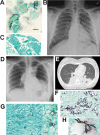Fungi that Infect Humans
- PMID: 28597822
- PMCID: PMC11687496
- DOI: 10.1128/microbiolspec.FUNK-0014-2016
Fungi that Infect Humans
Abstract
Fungi must meet four criteria to infect humans: growth at human body temperatures, circumvention or penetration of surface barriers, lysis and absorption of tissue, and resistance to immune defenses, including elevated body temperatures. Morphogenesis between small round, detachable cells and long, connected cells is the mechanism by which fungi solve problems of locomotion around or through host barriers. Secretion of lytic enzymes, and uptake systems for the released nutrients, are necessary if a fungus is to nutritionally utilize human tissue. Last, the potent human immune system evolved in the interaction with potential fungal pathogens, so few fungi meet all four conditions for a healthy human host. Paradoxically, the advances of modern medicine have made millions of people newly susceptible to fungal infections by disrupting immune defenses. This article explores how different members of four fungal phyla use different strategies to fulfill the four criteria to infect humans: the Entomophthorales, the Mucorales, the Ascomycota, and the Basidiomycota. Unique traits confer human pathogenic potential on various important members of these phyla: pathogenic Onygenales comprising thermal dimorphs such as Histoplasma and Coccidioides; the Cryptococcus spp. that infect immunocompromised as well as healthy humans; and important pathogens of immunocompromised patients-Candida, Pneumocystis, and Aspergillus spp. Also discussed are agents of neglected tropical diseases important in global health such as mycetoma and paracoccidiomycosis and common pathogens rarely implicated in serious illness such as dermatophytes. Commensalism is considered, as well as parasitism, in shaping genomes and physiological systems of hosts and fungi during evolution.
Figures

References
Publication types
MeSH terms
LinkOut - more resources
Full Text Sources
Other Literature Sources
Medical
Miscellaneous

